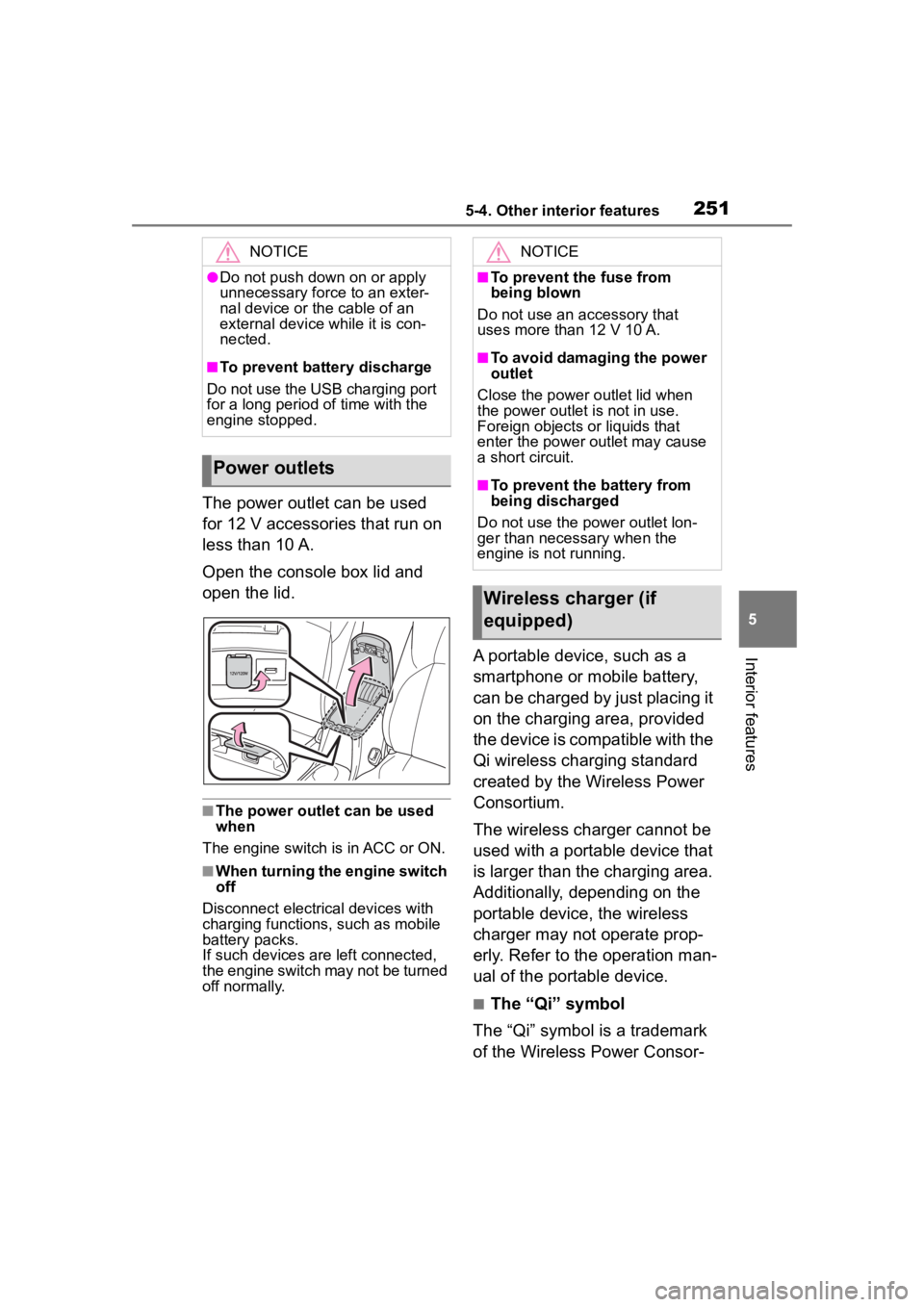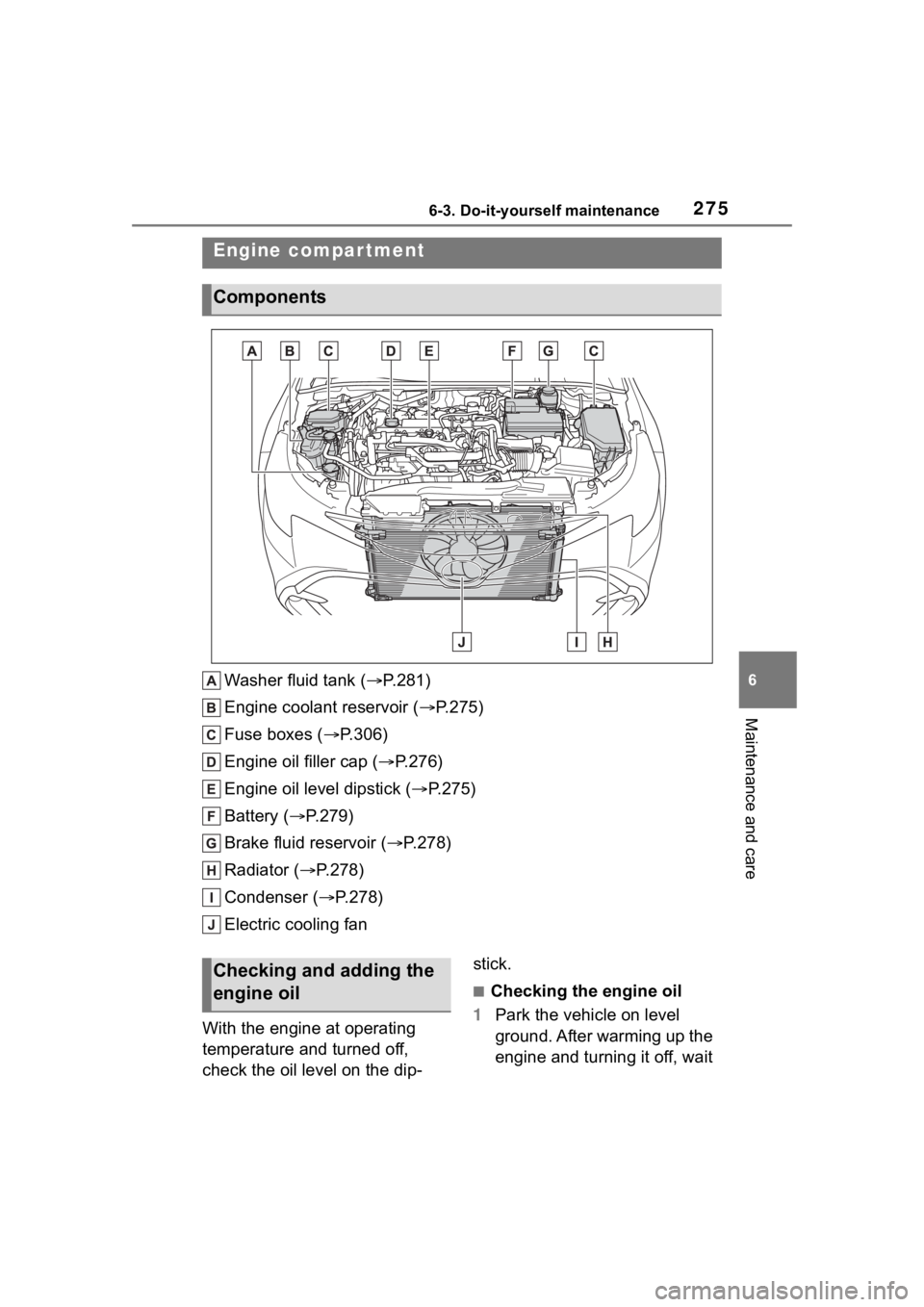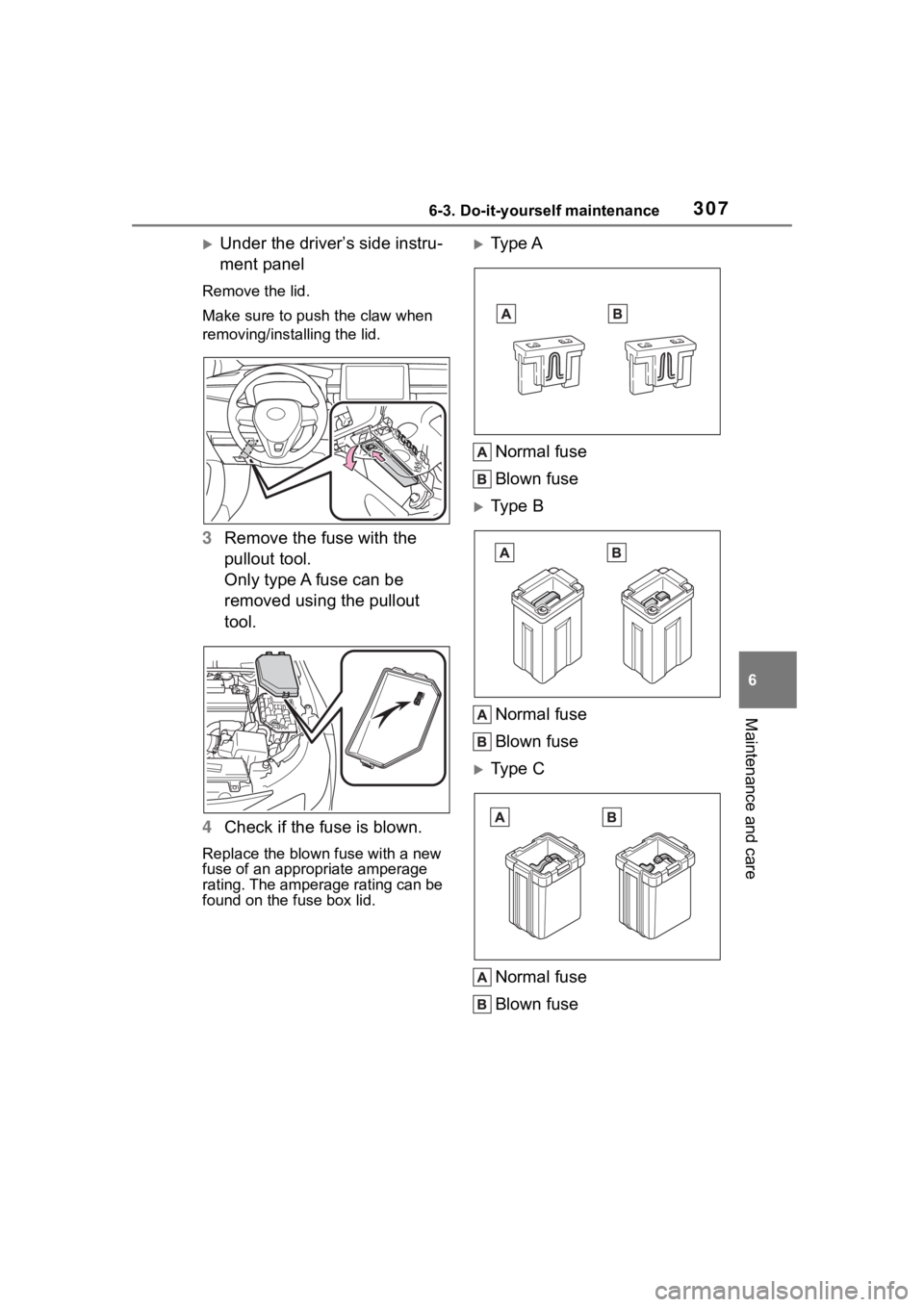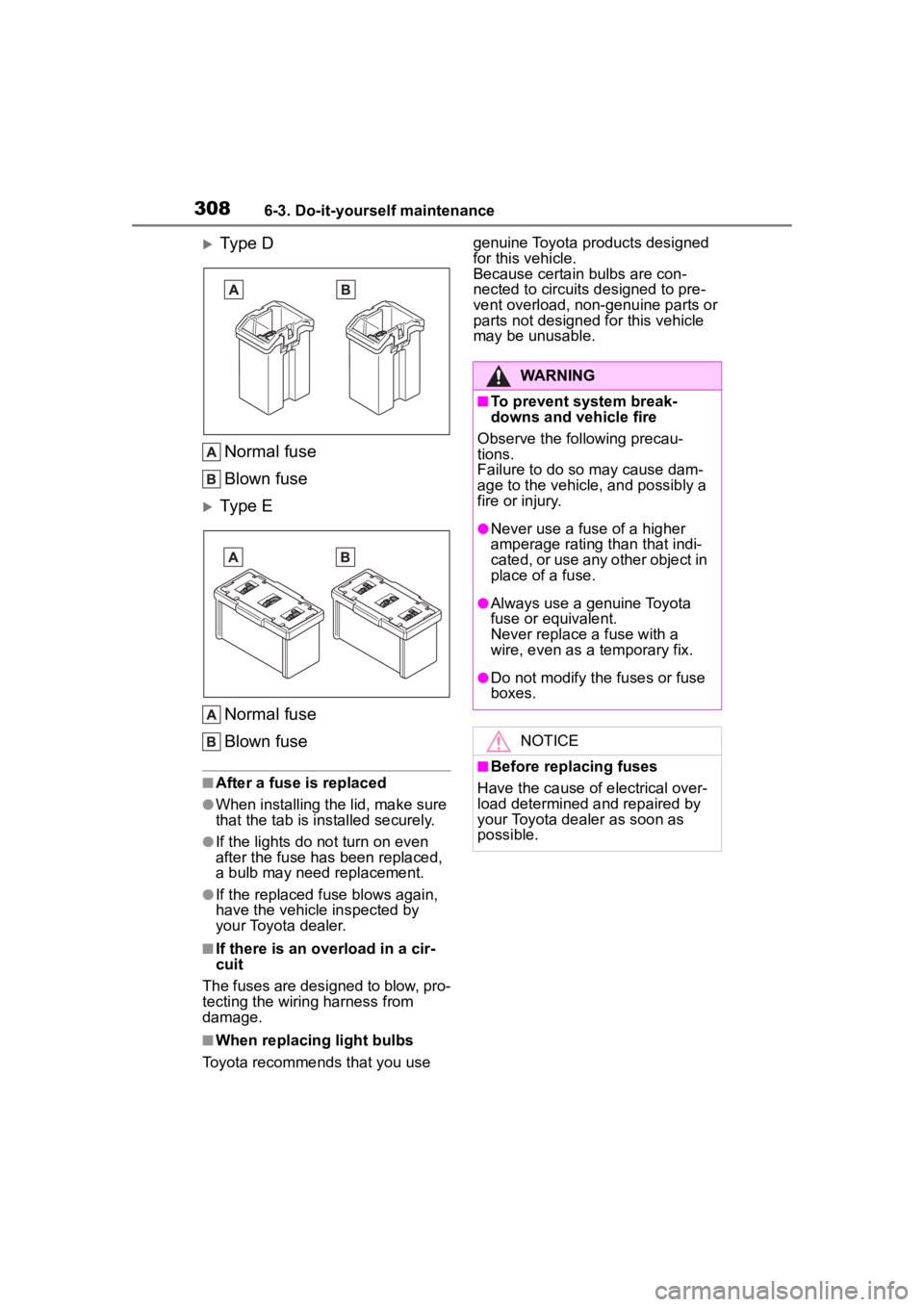fuse box TOYOTA COROLLA HATCHBACK 2023 Owners Manual
[x] Cancel search | Manufacturer: TOYOTA, Model Year: 2023, Model line: COROLLA HATCHBACK, Model: TOYOTA COROLLA HATCHBACK 2023Pages: 436, PDF Size: 8.72 MB
Page 251 of 436

2515-4. Other interior features
5
Interior features
The power outlet can be used
for 12 V accessories that run on
less than 10 A.
Open the console box lid and
open the lid.
■The power outlet can be used
when
The engine switch is in ACC or ON.
■When turning the engine switch
off
Disconnect electrical devices with
charging functions, such as mobile
battery packs.
If such devices are left connected,
the engine switch may not be turned
off normally.
A portable device, such as a
smartphone or mobile battery,
can be charged by just placing it
on the charging area, provided
the device is compatible with the
Qi wireless charging standard
created by the Wireless Power
Consortium.
The wireless charger cannot be
used with a portable device that
is larger than the charging area.
Additionally, depending on the
portable device, the wireless
charger may not operate prop-
erly. Refer to the operation man-
ual of the portable device.
■The “Qi” symbol
The “Qi” symbol is a trademark
of the Wireless Power Consor-
NOTICE
●Do not push down on or apply
unnecessary force to an exter-
nal device or the cable of an
external device while it is con-
nected.
■To prevent battery discharge
Do not use the USB charging port
for a long period of time with the
engine stopped.
Power outlets
NOTICE
■To prevent the fuse from
being blown
Do not use an accessory that
uses more than 12 V 10 A.
■To avoid damaging the power
outlet
Close the power outlet lid when
the power outlet is not in use.
Foreign objects or liquids that
enter the power outlet may cause
a short circuit.
■To prevent the battery from
being discharged
Do not use the p ower outlet lon-
ger than necessary when the
engine is not running.
Wireless charger (if
equipped)
Page 275 of 436

2756-3. Do-it-yourself maintenance
6
Maintenance and care
Washer fluid tank (P.281)
Engine coolant reservoir ( P.275)
Fuse boxes ( P.306)
Engine oil filler cap ( P.276)
Engine oil level dipstick ( P.275)
Battery ( P.279)
Brake fluid reservoir ( P.278)
Radiator ( P.278)
Condenser ( P.278)
Electric cooling fan
With the engine at operating
temperature and turned off,
check the oil level on the dip- stick.
■Checking the engine oil
1 Park the vehicle on level
ground. After warming up the
engine and turning it off, wait
Engine compar tment
Components
Checking and adding the
engine oil
Page 306 of 436

3066-3. Do-it-yourself maintenance
1Turn the engine switch off.
2 Open the fuse box cover.
Engine compartment: type A
fuse box
Push the tabs in and lift the lid off.
Engine compartment: type B
fuse box
Push the tabs in and lift the lid off.
WARNING
●If you accidentally swallow a
battery or put a b attery into a
part of your body, get emer-
gency medical attention imme-
diately.
■To prevent battery explosion
or leakage of flammable liq-
uid or gas
●Replace the battery with a new
battery of the same type. If a
wrong type of battery is used, it
may explode.
●Do not expose batteries to
extremely low pressure due to
high altitude or extremely high
temperatures.
●Do not burn, bre ak or cut a bat-
tery.
NOTICE
■When replacing the battery
Use a flathead screwdriver of
appropriate size. Applying exces-
sive force may deform or damage
the cover.
■For normal operation after
replacing the battery
Observe the following precautions
to prevent accidents:
●Always work with dry hands.
Moisture may cau se the battery
to rust.
●Do not touch or move any other
component inside the remote
control.
●Do not bend either of the battery
terminals.
Checking a nd replac-
ing fuses
If any of the electrical com-
ponents do not operate, a
fuse may have blown. If this
happens, check and replace
the fuses as necessary.
Checking and replacing
fuses
Page 307 of 436

3076-3. Do-it-yourself maintenance
6
Maintenance and care
Under the driver’s side instru-
ment panel
Remove the lid.
Make sure to push the claw when
removing/installing the lid.
3Remove the fuse with the
pullout tool.
Only type A fuse can be
removed using the pullout
tool.
4 Check if the fuse is blown.
Replace the blown fuse with a new
fuse of an appropriate amperage
rating. The amperage rating can be
found on the fuse box lid.
Type A
Normal fuse
Blown fuse
Type B
Normal fuse
Blown fuse
Type CNormal fuse
Blown fuse
Page 308 of 436

3086-3. Do-it-yourself maintenance
Type D
Normal fuse
Blown fuse
Type E
Normal fuse
Blown fuse
■After a fuse is replaced
●When installing the lid, make sure
that the tab is installed securely.
●If the lights do n ot turn on even
after the fuse has been replaced,
a bulb may need replacement.
●If the replaced fuse blows again,
have the vehicle inspected by
your Toyota dealer.
■If there is an overload in a cir-
cuit
The fuses are designed to blow, pro-
tecting the wiring harness from
damage.
■When replacing light bulbs
Toyota recommends that you use genuine Toyota pr
oducts designed
for this vehicle.
Because certain bulbs are con-
nected to circuits designed to pre-
vent overload, non-genuine parts or
parts not designed for this vehicle
may be unusable.
WARNING
■To prevent system break-
downs and vehicle fire
Observe the following precau-
tions.
Failure to do so may cause dam-
age to the vehicle, and possibly a
fire or injury.
●Never use a fuse of a higher
amperage rating than that indi-
cated, or use any other object in
place of a fuse.
●Always use a genuine Toyota
fuse or equivalent.
Never replace a fuse with a
wire, even as a temporary fix.
●Do not modify the fuses or fuse
boxes.
NOTICE
■Before replacing fuses
Have the cause of electrical over-
load determined and repaired by
your Toyota dealer as soon as
possible.
Page 414 of 436

414Alphabetical Index
Ignition switch (engine switch)........................................... 133
Overheating ......................... 362
Tachometer ............................ 72
Engine coolant Capacity ............................... 369
Checking .............................. 277
Preparing and c hecking before
winter.................................. 230
Engine coolant temperature gauge................................. 72, 75
Engine immobilizer system ..... 64
Engine oil Capacity ............................... 368
Checking .............................. 275
Preparing and c hecking before
winter.................................. 230
Warning light ........................ 321
Engine switch ......................... 133 Auto power off function ........ 136
Changing the engine switch modes ................................ 135
If your vehicle has to be stopped in an emergency................. 312
Enhanced VSC ........................ 226
EPS (Electric Power Steering) ............................................... 226Warning light ........................ 322
Event data recorder (EDR)......... 8
F
Flat tire Tire pressure warning system........................................... 285
Vehicles without a spare tire 334
Floor mats ................................. 24
Fluid Brake .................................... 370
Continuously variable transmis-sion..................................... 369
Washer ................................. 281 Fog lights ................................153
Replacing light bulbs ............309
Switch ...................................153
Front fog lights Replacing light bulbs ............309
Switch ...................................153
Front passenger occupant clas- sification system ....................40
Front seats Adjustment ...........................107
Cleaning ...............................262
Correct driving posture ...........25
Head restraints ..................... 110
Seat heaters ....... ..................241
Front side marker lights Light switch...........................148
Front turn signal lights Replacing light bulbs ............309
Turn signal lever ...................141
Fuel Capacity ...............................367
Fuel gauge .......................72, 75
Fuel pump shut off system ...319
Information ......... ..................373
Refueling ..............................157
Type......................................367
Warning light.........................323
Fuel consumption Average fuel economy ......79, 84
Current fuel consumption .79, 84
Fuel economy .....................79, 84
Fuel filler door Refueling ..............................157
Fuel gauge...........................72, 75
Fuel pump shut off system ....319
Fuses .......................................306
G
Gauges ................................72, 75
Glove box ................................246
Glove box light........................246
Grocery bag hooks .................248